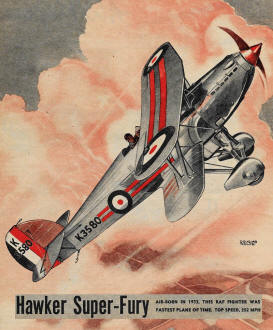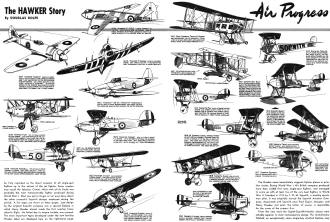|
Even when you are supremely
talented as both an artist, researcher, and writer, as was Douglas Rolfe,
producing the infographics, paintings, and articles like this 1950 Air
Trails magazine piece for the "Air Progress: The Hawker Story" feature,
requires an enormous amount of time and effort. Unlike today where most of the
information (accurate or not) you want is available on the Internet, back in
Rolfe's day, a library of books and magazines was needed to assimilate so much
information on a single subject - in this case the lineage and evolution of the
Hawker line of aircraft from its beginnings in 1912 under the name of Sopwith.
In 1950, Hawker's newest airplane was the P-1050 jet (c1949), which followed
Tempest (c1947) Typhoon (c1940), which became famous during World War II. Hawker
merged with Siddeley (Hawker Siddeley Aircraft) in 1963.
Their latest model is the
Hawk (now BAE
Systems), introduced in 1976.
Air Progress: The Hawker Story

Hawker Super-Fury Air-Born in 1933, this RAF Fighter was fastest
plane of time. Top Speed, 252 MPH
By Douglas Rolfe
The Hawker name immediately suggests fighter planes in aviation circles. During
World War I this British company produced more than 12,000 first class single-seat
fighters, and managed to come up with at least two of the very best fighters in
World War II. Founded in 1912 by T. O. M. Sopwith, a wealthy sportsman pilot, it
was originally named the Sopwith Aviation Company. Associated with Sopwith were
Fred Sigrist, designer, and Harry Hawker, test pilot. The latter, of course, is
responsible for the name of the present firm.
From the very start the Sigrist-Sopwith-Hawker planes were notably superior to
most contemporary design. The revolutionary Tabloid, an exceptionally clean single-bay
strutted biplane may be truly regarded as the direct ancestor of all single-seat
fighters up to the advent of the jet fighter. Some readers may recall the fabulous
Camel, which with all its faults was probably the most maneuverable fighter produced
during World War I. Most are apt to forget or not even know about the other successful
Sopwith designs employed during this period. A few types are shown on these pages.
Last design by the original Sopwith company was a special biplane in which Harry
Hawker almost made the first nonstop transatlantic flight. He failed due to engine
trouble, was rescued. The more important types developed under the now familiar
Hawker label are displayed here on the right-hand page.
1912 First Sopwith Tractor Design Was remarkable for its unusually
clean lines in an age when most airplanes were hardly more than crude powered kites.
 1912 Sopwith Bat Boat 90-H.P. Autro-Daimler engine. One of the
few pusher types produced by this company, the Bat-Boat takes its place in air progress
as the world's first genuine amphibian (the earlier Fabre "Amphibian" was not equipped
with wheels - made float landing on open sandy beaches). 1912 Sopwith Bat Boat 90-H.P. Autro-Daimler engine. One of the
few pusher types produced by this company, the Bat-Boat takes its place in air progress
as the world's first genuine amphibian (the earlier Fabre "Amphibian" was not equipped
with wheels - made float landing on open sandy beaches).
1915 Sopwith Pup 80-H.P. Le Rhone Rotary Engine. Max. speed
110 M.P.H. First of an unbroken line of Sopwith and Hawker single seat fighters,
the Pup was devoid of vices, and an unusually sweet-flying aeroplane.
1916-18 Sopwith Camel Variously powered with rotary engines
- ranging from the 110-H.P. Le Rhone up to the 230-H.P. Bentley B.R.2 - the Camel
was noted for its extra-ordinary maneuverability, its excellent climb and its vicious
habits in the hands of careless pilots. Max. speed was 124 M.P.H.
1918 Sopwith Snipe 230-H.P. B.R.2 rotary engine. Max. speed
was 131 M.P.H. A modified version, the Salamander, was armored for low-level attack.
1918 Sopwith Cuckoo 200-H.P. Hispano-Suiza V-8 engine. World's
first torpedo bomber specifically designed as such.
1913 Sopwith Tabloid 80-H.P. Gnome rotary engine Max Speed 92
M.P.H. The tabloid revolutionized all previous concepts of airplane performance
and is the ancestor of all present-day single-seat piston-engined fighters.
1914 Sopwith Baby Also known as the Sopwith "Schneider" since
the prototype won the 1914 Schneider Trophy Races. It was powered with either the
100-H.P. Monosoupape Gnome or the 110-H.P. Clerget Eng.
1916 Sopwith Tripe 130-H.P. Clerget rotary engine. Max. speed 123 M.P.H. It followed
a vogue introduced by Fokker.
1917 Sopwith Dolphin 200-H.P. Hispano-Suiza vee-8 engine. Top
speed 132 M.P.H.
1947 Hawker Tempest 2240 H.P. liquid-cooled 24-cylinder H-type
Napier Sabre engine. Last and fastest of the piston-engine Hawker fighters. Max.
speed 392 M.P.H. at sea level - 435 M.P.H. at 17,500 feet. An earlier version of
the Tempest was used with considerable success during the latter part of World War
2 to combat the V-1 Buzz-Bombs.
1936 Hawker Fury 745-H.P. Rolls-Royce Kestrel Engine. Last and
fastest of the numerous Fury models it was also the last biplane fighter from the
Hawker stable. Built for export it had a maximum speed of 252 M.P.H.
1926 Hawker Hornbill 700-H.P. Rolls-Royce Condor V-12 engine.
- Max. speed 196 M.P.H. - First of the high speed Hawker biplanes which culminated
in the Fury design shown immediately above this ship.
1949 Hawker P-1052 Latest Hawker jet fighter. Rolls-Royce Nene
jet engine. One of these aircraft flew from London to Paris (May 1939) in 20 minutes
- an average speed of 618 M.P.H.
1940 Hawker Typhoon 2,240-H.P. Napier engine. Max. speed 416
M.P.H. It was one of the most formidable fighters of World War No. 2.
1935 Hawker f-36 34 (Prototype Hurricane). 1025-H.P. Rolls-Royce
Merlin engine. Max. speed 325 M.P.H. The Hurricane made history during the Battle
of Britain.
1929 Hawker Hornet 450-H.P. Rolls-Royce F-XI engine. An in-between
step from the Hornbill to the first (1933) fury. Max. speed was 214 M.P.H. at 10,000
feet - with 350 less H.P. than the Hornbill!
1925 Hawker Cygnet 32-H.P. Bristol Cherub engine. This two-place
ultra-lightplane, lik most Hawker designs, was a thoroughly good airplane.
1923 Hawker Duiker 400-H.P. Bristol Jupiter engine. This 2-seat
Army liaison plane was one of the first designs produced under the now world-famous
Hawker label.
Posted May 4, 2024
|